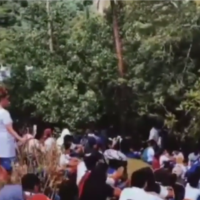
There are plenty of points to discuss after the Tsunami Warning issued for American Samoa yesterday. The need for continuing education and evacuation drills just may be the foremost.
After a 8.0 magnitude earthquake near Kermadek Islands prompted the warning from the National Weather Service around 8:30 a.m., the message was spread that tsunami waves could potentially reach the territory in about an hour and fifty minutes at 10:19 a.m.
Despite American Samoa’s tsunami warning siren system being inoperable, the National Weather Service (NWS), Emergency Operations Center (EOC) and local radio stations immediately went to work informing the public.

The initial 30 to 45 minutes of the Tsunami Warning seemed to go well. Word spread quickly and planning paid off as throughout the territory residents, businesses, agencies and schools began evacuations. That’s when 93KHJ radio hosts John Raynar & Sia Atofau began receiving phone calls and messages about slowing traffic in the Nu’uuli area.
At 9:45 a.m., the Tsunami Warning was downgraded to a Tsunami Advisory. EOC still called for people to continue with their evacuations. However, with only 40 minutes left until the original estimated arrival time of the first tsunami wave, not everyone was receiving and heeding the message. By then, westbound traffic had come to an absolute standstill in the curving section of the main road all the way to the airport road intersection in Nu’uuli. With much less eastbound traffic in the opposite lane, many drivers chose to skip the line.
Where they impatient and skipping the line? Were they simply scared and running for their lives? Regardless of the answer, people on the roads at this time now faced two dangers. The first was the impending tsunami. The second was dealing with unpredictable and perhaps frightened drivers barreling the wrong way down the eastbound lane.
The Dept. of Public Safety soon deployed officers to strategic intersections to direct drivers. By all accounts, this did get traffic moving again even though not everyone agreed on which roads they were forced to take. Very little traffic was observed in the Tafuna airport road area by 10:45 a.m. The ALL CLEAR was issues by Governor Lemanu Peleti Mauga about 11:20 a.m. and residents went about their day.
A formal analysis of yesterday’s events has not yet been completed by authorities but one question stands out above the rest. Why were people stuck in traffic when the territory had nearly two hours warning of a tsunami?
Many of those stuck in traffic were parents who desperately wanted to pick up their kids from school. Others who were dismissed from work and told to evacuate decided to drive home rather than seek the nearest high ground. It is clear that many people thought that they had enough time to reach their destinations but did not take into account the high volume of traffic.
Despite the issues with traffic, there were many successes yesterday as the fruits of lessons learned from the 2009 tsunami in American Samoa were displayed to all. Reports flooded in from all corners of the island as school, businesses and agencies successfully put their long practiced evacuation plans to good use. Within 20 minutes of the initial alert, students of the Nu’uuli Vocational Technical High School in the Lions Park were observed walking by the studios of 93KHJ at the intersection of the airport and Fagaima roads. This same display of orderly and timely evacuations was repeated at all schools in tsunami inundation zones.
However, it seems that continuing education for individuals is still needed. The A.S. Dept of Homeland Security reminds you that when a tsunami warning is sounded, you should seek higher ground immediately. Stay off the roads. Have a family plan. Know where your children and other loved ones will be in the event of a major disaster. Practice your plans and when disaster comes, work the plan.
More follow up coverage on yesterdays tsunami event is to come in future news bulletins.





